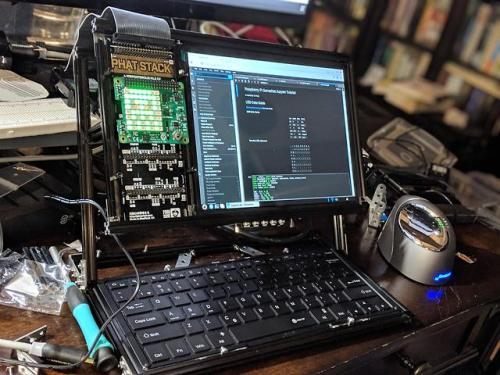Interesting :)
Interesting :)
Decentralized Manufacturing: The New Frontier

I've already discussed the importance of forming networks of resilience against corporate encroachment in local communities before. One of those networks consists of manufacturing, specifically decentralized manufacturing. One hallmark of this venture will be 3D printing.
Given how corporations weaponize convenience to extract everything from communities (the Walmart effect), communities must be able to provide for themselves. Obviously, learning a trade and teaching it to your kids is half the battle. The other half will inevitably come down to adopting new technology (such as 3D printing) without subjecting yourself to the tech companies that will attempt to control this. 3D printing has the capability to cover building parts for everything from construction, to automotive, to even pharmaceutical products, and most controversially, guns.
That said, this has to happen in an open source environment. Playing into the IP law game will simply result in your ideas getting acquired by a corp and sued into bankruptcy. You're not gonna beat these guys at your own game, and IP laws are flagrantly anti-free market anyway (a topic I won't get into here.) If you want to protect your liberties, you're going to have to learn when to band together against bigger threats.
Here's some resources to get started:
What is 3D printing?
Free download able 3D printing files
Best affordable open source 3D printers
Have at it folks.
More Posts from Forward-lang-blog and Others
The best pull request (PR) in 2017???


Never interrupt a programmer
I don't think other coworkers understand how complicated and stressful it is to explain what's going on in your head when you don't even understand specific problems when coding. Hence, I don't want anyone to disrupt me. Same thought in comic format:

Do you agree? Let me know in the comments below.
Credit

This guys raspberry pi laptop is goals via Cyberpunk
fractals!! :D or at least patterns :P







Johann Eduard Jacobsthal, “Süd-italienische Fliesen-Ornamente”, South italian tile ornaments, 1886. Chromolithography. Published by Ernst Wasmuth, Tübingen, Germany. Source: archive.org. Via frizzifrizzi
Summary:
online trainings on how to use NASA Earth science data, regarding:
air quality,
climate,
disaster,
health,
land,
water resources and
wildfire management.
Everyone (Even You!) Can Use Satellite Data
At NASA we’re pretty great at putting satellites and science instruments into orbit around Earth. But it turns out we’re also pretty great at showing people how to get and use all that data.
One of the top ways you can learn how to use NASA data is our ARSET program. ARSET is our Applied Remote Sensing Training program and it helps people build skills that integrate all these Earth science data into their decision making.

ARSET will train you on how to use data from a variety of Earth-observing satellites and instruments aboard the International Space Station.
Once you take a training, you’ll be in GREAT company because thousands of people have taken an ARSET training.

We hold in person and online trainings to people around the world, showing them how to use NASA Earth science data. Trainings are offered in air quality, climate, disaster, health, land, water resources and wildfire management.
For example, if you’re trying to track how much fresh drinking water there is in your watershed, you can take an ARSET training and learn how to find satellite data on how much precipitation has fallen over a certain time period or even things like the ‘moistness’ of soil and the quality of the water.

Best yet, all NASA Earth observing data is open and freely available to the whole world! That’s likely one of the reasons we’ve had participants from 172 of the approximately 190 countries on Earth.

Since its beginning 10 years ago, ARSET has trained more than 30 thousand people all over the world. They’ve also worked with people from more than 7,500 different organizations and that includes government agencies, non-profit groups, advocacy organizations, private industry.
And even though 2019 is ARSET’s 10th birthday – we’ve only just begun. Every year about 60% of the organizations and agencies we train are new to the program. We’re training just about anyone who is anyone doing Earth science on Earth!
Join us, learn more about how we train people to use Earth observing data here, and heck, you can even take a training yourself: https://arset.gsfc.nasa.gov/.
Make sure to follow us on Tumblr for your regular dose of space: http://nasa.tumblr.com
Researchers from the University of Tokyo created a “drone dragon” which is able to fly through tight spaces 🐉🐲 | Our audience: #nasa #mavicair #universityofmichigan #djiphantom4 #djiglobal #uav #mavicair #djiinspire1 #quadcopter #spacecamp #drone #robotics #robot #aerialphotography #fpv #drones #skynet #octocopter #djiphantom #arduino #hobbyking #drone #multirotor #dronephotography #sparkfun #tesla #raspberrypi #mavicpro #tokyodisneyland (at University of Tokyo)

the strongest









At the lab this week I made some printed circuit boards with my new collaborator Jonathan Bobrow. I also learned to solder some super small components to a board.

-
 chillonah liked this · 1 year ago
chillonah liked this · 1 year ago -
 liquidpaperfoundation1 reblogged this · 1 year ago
liquidpaperfoundation1 reblogged this · 1 year ago -
 liquidpaperfoundation1 liked this · 1 year ago
liquidpaperfoundation1 liked this · 1 year ago -
 hydralisk98 reblogged this · 2 years ago
hydralisk98 reblogged this · 2 years ago -
 hydralisk98 liked this · 2 years ago
hydralisk98 liked this · 2 years ago -
 theduchessofhearts reblogged this · 2 years ago
theduchessofhearts reblogged this · 2 years ago -
 theduchessofhearts liked this · 2 years ago
theduchessofhearts liked this · 2 years ago -
 grahminradarin reblogged this · 3 years ago
grahminradarin reblogged this · 3 years ago -
 datgirlsham liked this · 3 years ago
datgirlsham liked this · 3 years ago -
 ranibeibe liked this · 3 years ago
ranibeibe liked this · 3 years ago -
 red-prince-lio liked this · 3 years ago
red-prince-lio liked this · 3 years ago -
 violetnull reblogged this · 3 years ago
violetnull reblogged this · 3 years ago -
 violetnull liked this · 3 years ago
violetnull liked this · 3 years ago -
 redzonetheredstonenuker liked this · 3 years ago
redzonetheredstonenuker liked this · 3 years ago -
 an-alarming-number-of-bees reblogged this · 3 years ago
an-alarming-number-of-bees reblogged this · 3 years ago -
 naturally-ethereal liked this · 3 years ago
naturally-ethereal liked this · 3 years ago -
 deeper6 reblogged this · 3 years ago
deeper6 reblogged this · 3 years ago -
 thatwanchor liked this · 3 years ago
thatwanchor liked this · 3 years ago -
 deeper6 liked this · 3 years ago
deeper6 liked this · 3 years ago -
 7thgenscot liked this · 3 years ago
7thgenscot liked this · 3 years ago -
 barry4697 reblogged this · 3 years ago
barry4697 reblogged this · 3 years ago -
 barry4697 liked this · 3 years ago
barry4697 liked this · 3 years ago -
 traveler733 reblogged this · 3 years ago
traveler733 reblogged this · 3 years ago -
 imightbegoinginsanebutwhoknows liked this · 3 years ago
imightbegoinginsanebutwhoknows liked this · 3 years ago -
 nottheliterati reblogged this · 3 years ago
nottheliterati reblogged this · 3 years ago -
 theyoungwander liked this · 3 years ago
theyoungwander liked this · 3 years ago -
 desertrommel liked this · 3 years ago
desertrommel liked this · 3 years ago -
 zelu4590 liked this · 3 years ago
zelu4590 liked this · 3 years ago -
 bezow-dootdoot-zoppitybopbopbop liked this · 3 years ago
bezow-dootdoot-zoppitybopbopbop liked this · 3 years ago -
 theodoretheninja reblogged this · 3 years ago
theodoretheninja reblogged this · 3 years ago -
 angrybell reblogged this · 3 years ago
angrybell reblogged this · 3 years ago -
 merks-trash-fire liked this · 3 years ago
merks-trash-fire liked this · 3 years ago

28 posts